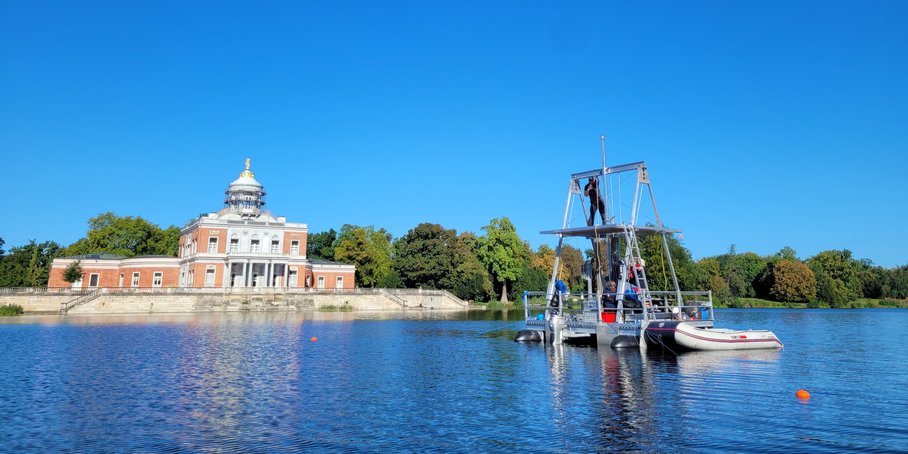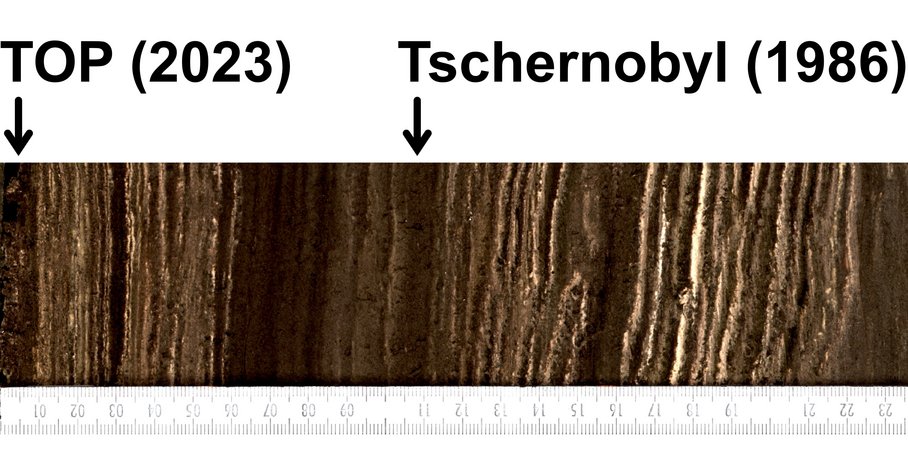A set of short sediment cores were retrieved in 2022 and 2023 from the UNESCO heritage site lake Heiliger See in the Park Neuer Garten by our team at GFZ, Stiftung Preußische Schlösser und Gärten Berlin-Brandenburg SPSG (Foundation Prussian palaces and gardens in Berlin and Brandenburg), and students of the Bertha von Suttner Gymnasium in Babelsberg, as part of the competition “Jugend Forscht” (Youth Research Competition). These sediment archives consist partly of annually laminated sediments, known as varves, which preserve seasonal changes in sediment deposition. Varves are only preserved if there is no or only minimal biological activity at the bottom of the lake. These sediments can be used to track detailed year by year environmental changes within the lake that can be linked to human activity or climate changes.
The sedimentary deposits examined to date from the top 130 cm of the deepest point of lake Heiliger See provide detailed insight into the history of the last 300 years. Significant changes in sediment composition and geochemical signature, e.g. stable isotopes (N, C, O), bear witness to environmental changes caused by urban development and the reconstruction of the park ”Neuer Garten”. The occurrence of annual layers (varves) offers a unique opportunity to study changes in environmental conditions caused by climatic developments and human influences in our region over a historical period.
The well-preserved varved sediments and the geochemical record of lake Heiliger See short cores are promising indications that this lake is a sensitive recorder of past natural and anthropogenic changes. The occurrence of annual layers offers a unique opportunity to study changes in environmental conditions caused by climatic developments and human influences in our region over a historical period.
A long sediment core has the potential to reveal a longer history of human activity and environmental and climatic changes around the lake Heiliger See. To this end, we want to obtain a 10-metre-long, continuous sediment profile from the deepest part of the lake. We will drill at least two parallel profiles, offset vertically by one metre. This will give us a continuous, complete sediment profile.
Based on our current knowledge, this sediment record should cover more than 10,000 years of sedimentation history. This valuable sediment archive will then be analysed using a wide variety of available scientific methods. In this way, we hope to reconstruct the Holocene development history of the lake and the surrounding landscape, possibly beginning with the transition from the glacial to the interglacial phase.
Although climatic conditions remained relatively stable during most of the Holocene, there were warmer and colder phases and short-term climate changes, such as a cold phase 8,200 years ago, warmer phases such as the ‘Roman Climate Optimum’ (250 BC–400 AD) and the ‘Medieval Climate Optimum’ (900–1,200 AD) and the ‘Little Ice Age’ (1,500–1,800 AD).
In addition to natural changes caused by climatic developments, we are also looking for evidence of Potsdam's settlement history, which dates back to the Mesolithic period. Human activities around the lake are to be identified on the basis of human-induced erosion, altered biomarkers and geochemical indicators, as well as changes in the vegetation and hydrology of the lake.


